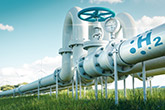Bloom Energy to power green hydrogen microgrid in India
Published by Bella Weetch,
Editorial Assistant
Global Hydrogen Review,
Bloom Energy announced that NTPC Ltd, India’s largest energy conglomerate under the jurisdiction of the Ministry of Power, has selected Bloom’s electrolyser and hydrogen-powered fuel cell technologies for the country’s first green hydrogen-based energy storage deployment. As part of India’s pledge to reach carbon neutrality by 2070, the project is designed to explore large-scale, off-grid hydrogen energy storage and microgrid projects at strategic locations throughout the country.
Bloom Energy (India) Private Ltd, a wholly owned subsidiary of Bloom Energy, was selected for its holistic, comprehensive and efficient technology ecosystem spanning green hydrogen production and carbon-free power. The initial collaboration between NTPC and Bloom Energy India is expected to serve as a foundation for expanded future cooperation.
The collaboration will utilise Bloom Energy’s solid oxide, high temperature electrolyser to generate green hydrogen from renewable electricity produced by a nearby floating solar farm. The hydrogen will then be converted into carbon neutral electricity without combustion through Bloom Energy’s hydrogen fuel cells to power NTPC’s Guest House, a local accommodation intended for use by NTPC employees and guests. The project is expected to commence in 2022 in Simhadri, Visakhapatnam, India.
The solar farm coupled with Bloom Energy’s electrolyser and hydrogen fuel cells is intended to operate around the clock. At scale, the combination could enable long duration clean energy storage and resilient power for businesses, residential neighbourhoods, dense urban areas, and remote and island communities.
India is pursuing aggressive plans to move towards renewable energy and storage capacity while ensuring grid stabilization for its citizens. Hydrogen is a natural complement to renewable sources of energy, leveraging excess peak power created during the day for conversion into hydrogen to provide pollution-free, reliable power that provides long-duration storage.
Bloom Energy’s high-temperature electrolyser produces hydrogen more efficiently than low-temperature PEM and alkaline electrolysers. Because it operates at high temperatures, the Bloom electrolyser requires less energy to break up water molecules and produce hydrogen. Electricity accounts for nearly 80% of the cost of hydrogen from electrolysis. By using less electricity, hydrogen production becomes more economical and will accelerate adoption.
Bloom Energy Servers – solid oxide fuel cells that combine ambient air with a fuel source, such as natural gas, biogas, hydrogen, or a blend of fuels – produce electricity through a non-combustion electrochemical reaction, resulting in reduced carbon emissions, harmful air pollutants, and water use compared to grid alternatives. When hydrogen is used as a fuel source, Bloom Energy Servers emit zero carbon.
Bloom Energy is engaged with industry leaders to accelerate the global hydrogen economy, including projects related to producing low-cost, green hydrogen and utilising nuclear energy to create clean hydrogen.
Read the article online at: https://www.globalhydrogenreview.com/hydrogen/30122021/bloom-energy-to-power-green-hydrogen-microgrid-in-india/
You might also like
Mainzer to develop hydrogen pipeline in Germany
As part of a new project called H2 Initial Network Mainz, Mainzer Netze and its partner Hy2gen are planning to build an initial hydrogen network in the industrial area of Mainz Neustadt and Mombach, Germany.

